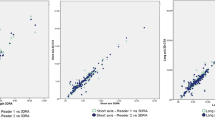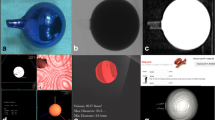Abstract
Introduction
Exact quantification of vasospasm by angiography is known to be difficult especially in small vessels. The purpose of the study was to develop a new method for computerized analysis of small arteries and to demonstrate feasibility on cerebral angiographies of rats acquired on a clinical angiography unit.
Methods
A new software tool analysing grey values and subtracting background noise was validated on a vessel model. It was tested in practice in animals with subarachnoid haemorrhage (SAH). A total of 28 rats were divided into four groups: SAH untreated, SAH treated with local calcium antagonist, SAH treated with placebo, and sham-operated. The diameters of segments of the internal carotid, caudal cerebral, middle cerebral, rostral cerebral and the stapedial arteries were measured and compared to direct measurements of the diameters on magnified images.
Results
There was a direct correlation between the cross-sectional area of vessels measured in a phantom and the measurements acquired using the new image analysis method. The spread of repeated measurements with the new software was small compared to the spread of direct measurements of vessel diameters on magnified images. Application of the measurement tool to experimental SAH in rats showed a statistically significant reduction of vasospasm in the SAH groups treated with nimodipine-releasing pellets in comparison to all the other groups combined.
Conclusion
The presented computerized method for analysis of small intracranial vessels is a new method allowing precise relative measurements. Nimodipine-releasing subarachnoidal pellets reduce vasospasm, but further testing with larger numbers is necessary. The tool can be applied to human angiography without modification and offers the promise of substantial progress in the diagnosis of vasospasm after SAH.





Similar content being viewed by others
References
Boullin DJ, Aitken V, du Boulay GH, Tagari P (1981) The cerebral arteries of the rat studied by carotid angiography: a model system for studying the aetiology of human cerebral arterial constriction after aneurysmal rupture. Neuroradiology 21:245–252
Longo M, Blandino A, Ascenti G, Ricciardi GK, Granata F, Vinci S (2002) Cerebral angiography in the rat with mammographic equipment: a simple, cost-effective method for assessing vasospasm in experimental subarachnoid haemorrhage. Neuroradiology 44:689–694
Luedemann W, Brinker T, Schuhmann MU, von Brenndorf Al, Samil M (1998) Direct magnification technique for cerebral angiography in the rat. Invest Radiol 33:421–424
Reese T, Bochelen D, Sauter A, Beckmann N, Rudin M (1999) Magnetic resonance angiography of the rat cerebrovascular system without the use of contrast agents. NMR Biomed 12:189–196
Ono S, Date I, Nakajima M, Onoda K et al (1997) Three-dimensional analysis of vasospastic major cerebral arteries in rats with the corrosion cast technique. Stroke 28:1631–1637
Delgado TJ, Brismar J, Svendgaard NA (1985) Subarachnoid haemorrhage in the rat: angiography and fluorescence microscopy of the major cerebral arteries. Stroke 16:595–602
Turowski B, du Mesnil de Rochemont R, Beck J, Berkefeld J, Zanella FE (2005) Assessment of changes in cerebral circulation time due to vasospasm in a specific arterial territory: effect of angioplasty. Neuroradiology 47:134–143
Wahlert JH (1974) The cranial foramina of protrogomorphous rodents an anatomical and phylogenetic study. Bull Mus Comp Zool 146(8):363–410
Popesko P, Rajtová V, Horák J (1990) Atlas of the anatomy of small laboratory animals, vol. 2: rat, mouse and golden hamster. Priroda, Bratislava; English translation, Wolfe, 1992, p 23
Vatter H, Weidauer S, Konczalla J, Dettmann E, Zimmermann M, Raabe A, Preibisch C, Zanella FE, Seifert V (2006) Time course in the development of cerebral vasospasm after experimental subarachnoid hemorrhage: clinical and neuroradiological assessment of the rat double hemorrhage model. Neurosurgery 58:1190–1197; discussion 1190–1197
Verlooy J, Van Reempts J, Haseldonckx M, Borgers M, Selosse P (1992) The course of vasospasm following subarachnoid haemorrhage in rats. A vertebrobasilar angiographic study. Acta Neurochir (Wien) 117:48–52
Conflict of interest statement
We declare that we have no conflict of interest.
Author information
Authors and Affiliations
Corresponding author
Rights and permissions
About this article
Cite this article
Turowski, B., Hänggi, D., Beck, A. et al. New angiographic measurement tool for analysis of small cerebral vessels: application to a subarachnoid haemorrhage model in the rat. Neuroradiology 49, 129–137 (2007). https://doi.org/10.1007/s00234-006-0168-y
Received:
Accepted:
Published:
Issue Date:
DOI: https://doi.org/10.1007/s00234-006-0168-y




